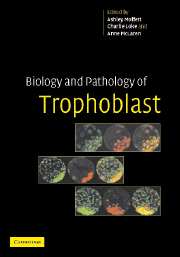Book contents
- Frontmatter
- Contents
- List of contributors
- List of participants
- Preface
- Chair's introduction
- 1 Trophoblast cell fate specification
- 2 Stem cells: pluripotency and extraembryonic differentiation in the mouse
- 3 Epigenetic regulation of trophoblast development
- 4 Regulation of X-chromosome inactivation in relation to lineage allocation in early mouse embryogenesis
- General discussion I
- General discussion II
- Final general discussion
- Index
- Plate section
- References
Preface
Published online by Cambridge University Press: 07 August 2009
- Frontmatter
- Contents
- List of contributors
- List of participants
- Preface
- Chair's introduction
- 1 Trophoblast cell fate specification
- 2 Stem cells: pluripotency and extraembryonic differentiation in the mouse
- 3 Epigenetic regulation of trophoblast development
- 4 Regulation of X-chromosome inactivation in relation to lineage allocation in early mouse embryogenesis
- General discussion I
- General discussion II
- Final general discussion
- Index
- Plate section
- References
Summary
A major step in the evolution of eutherian mammals was the formation of the trophoblast, a specialised layer of cells derived early in embryogenesis. From this separate compartment, trophoblast is able to organise its own programme of development within a well-defined time span that is independent of the embryo, thereby enabling it to fulfil unique functions during ontogeny. While trophoblast contributes to the formation of the placenta in all eutherians, the manner by which it does so varies significantly among species (Carter 2001). It is important to recognise the pattern and extent of these variations if dialogue between investigators using human and those using animal material is to be meaningful. The trophoblast cell itself occurs in different forms ranging from uninuclear to multinuclear varieties, the latter appearing either as large giant cells or as a syncytium. Some of the giant cells are polytenic whilst others are polyploid but it is not known why these occur in different locations and time points of gestation in different species.
Trophoblast cells have remarkable growth and invasive properties in vivo, so much so that they resemble neoplastic cells, yet the in vitro culture and propagation of human trophoblast cells have still not met with much success. The recent realisation that some ‘trophoblast’ cell lines presently available are not what they seem to be has raised questions about how these cells should be characterised (King et al. 2000).
- Type
- Chapter
- Information
- Biology and Pathology of Trophoblast , pp. xi - xivPublisher: Cambridge University PressPrint publication year: 2006



